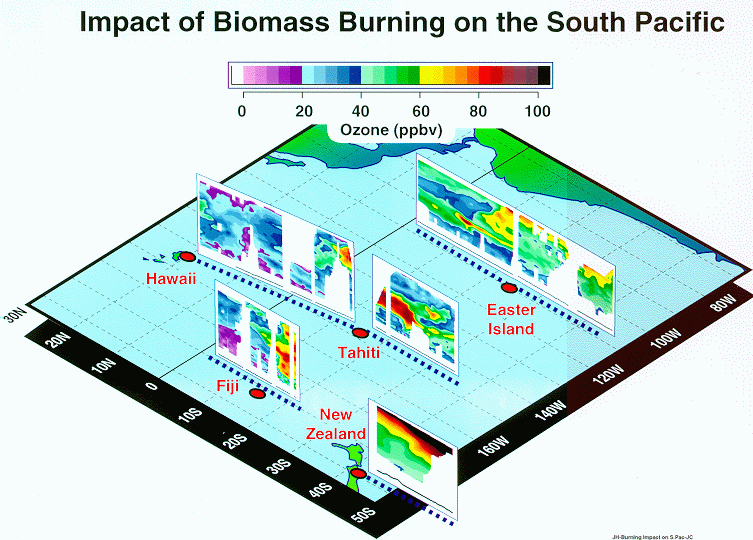![[Earth]](../img/earth.gif)
PEM Tropics Results
![[GTE Logo]](../img/gte_slogo.gif)
![[Earth]](../img/earth.gif) |
PEM Tropics Results |
![[GTE Logo]](../img/gte_slogo.gif) |
The GTE Pacific Exploratory Mission in the Tropics (referred to as PEM-Tropics) represents the first comprehensive survey of tropospheric chemistry on the southern Pacific, a particularly remote, photochemically and radiatively important part of the world. The objectives of PEM-Tropics are to provide baseline data in this region for species important to global photochemistry and climate, and to determine the factors controlling the concentrations of these species. A particular focus of PEM-Tropics is on understanding the origin of tropospheric ozone (O3) and its precursors, and to assess the implications for future change in the global oxidizing power of the atmosphere as a result of human and natural influences.
PEM-Tropics was conducted late August to early October 1996, and involved over 100 scientists and technicians with instrumentation on board the NASA DC-8 and P-3B aircraft. The two aircraft conducted coordinated flights from bases in Isla de Pascua (Easter Island), Chile; Papeete, Tahiti; the P3-B conducted studies from Kritimati (Christmas Island) and Guayaquil, Ecuador while the DC-8 was based in Christchurch, New Zealand and Nadi, Fiji.
Initial results from PEM-Tropics have been spectacular. Improvements in instrument sensitivity (e.g. OH, NO, and H2SO4) demonstrated during PEM-Tropics, have allowed a unique study of the oxidation of oceanic emissions of dimethylsulfide to SO4, to H2SO4, and finally to ultra fine aerosols. Analysis of these results are anticipated to permit a more definitive estimate of the oceanic source for cloud condensation nuclei. A particularly surprising observation has been the pervasiveness of biomass burning plumes throughout the southern Pacific region. Initial assessment is that these plumes, containing O3 at concentrations that typically are observed in pollution events in the U. S., are thought to originate as far west as Africa and extend as far east as Easter Island. The the long range impact of biomass burning is a clear enhancement in O3through out the southern Pacific region.

|
|
A differential absorption LIDAR (DIAL) system aboard the NASA DC-8 aircraft provided measurements of the vertical distributions of ozone below and above the aircraft flight path. The vertical profiles from the DAIL system clearly show layers in the troposphere over the southern Pacific ocean with elevated concentrations of ozone (The orange and red sections in the inserts above.) These layers are associated with the long range transport of pollution in to this region. While additional analysis of the trace gases measured within these plumes will be required to quantify the source(s), it is clear already that some of the plumes originate from biomass burning sources, perhaps as far west as Africa. (See results from the GTE TRACE-A mission.) |
[Return to the GTE
Home Page]
[Return to the GTE Field Missions]
[Feedback]